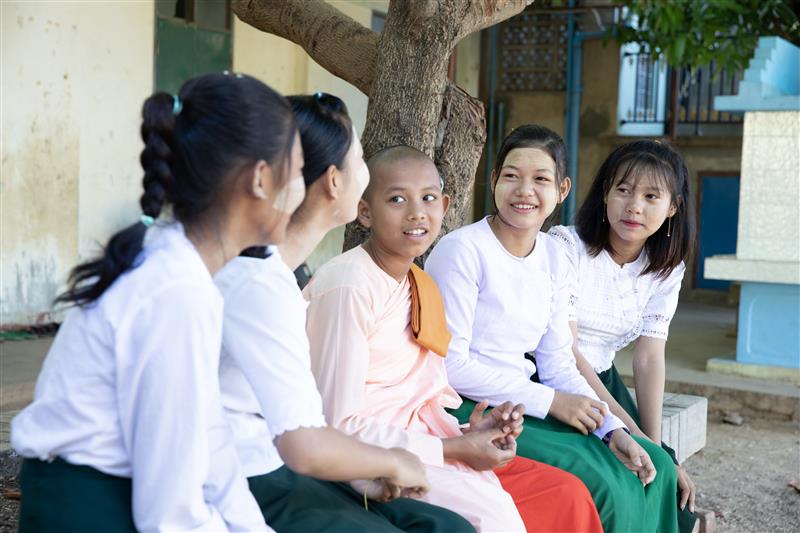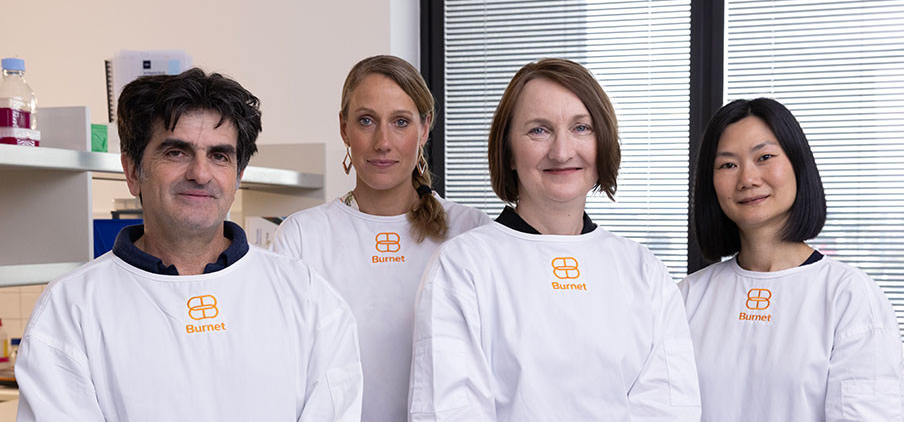Malaria Synergy Program
The Malaria Synergy Program (MSP) brings together experts with complementary expertise into a multidisciplinary program to address major roadblocks to achieving the goals of malaria elimination in the Asia-Pacific region and globally.
Malaria is a major global health problem. Progress in reducing the global burden stalled in 2015 and the burden increased in 2020. The Malaria Synergy Program aims to generate new knowledge, tools, and strategies to overcome major roadblocks in malaria detection, treatment, and prevention to accelerate progress towards elimination of malaria caused by P. Falciparum and P. vivax.
Timeline
2023–2028.
Approach
The Malaria Synergy Program investigators and our teams will focus on developing novel approaches to optimise drug treatment, achieving highly efficacious and long-lasting vaccines, and developing novel tools to map and discover drivers of malaria transmission.
Our 3 core themes are:
- new tools to detect and target malaria transmission; develop multi-parameter tools to accurately measure malaria transmission and guide targeted interventions and predict the emergence and spread of drug resistance
- optimising drug treatments and combating resistance; optimise antimalarial combination therapies to treat drug-resistant P. falciparum malaria and develop strategies to better target P. vivax and clear dormant liver-stage infections
- maximising the efficacy and impact of vaccines; identify the key determinants of vaccine efficacy and longevity and define antigenic diversity of vaccine candidates and identify strategies to overcome vaccine escape.
Student opportunities
Genomic epidemiology of the neglected malaria parasite, Plasmodium malariae
Plasmodium malariae is a neglected malaria parasite, overshadowed by P. falciparum and P. vivax. The symptoms from P. malariae infections are often mild or absent, necessitating sensitive and targeted screening to detect these infections. Using these methods, studies reveal increased prevalence of P. malariae in areas where other species have decreased. Despite this, P. malariae infection dynamics and relationship to other species remains poorly understood. With advanced sequencing techniques we aim to describe the epidemiology and infection dynamics of this understudied parasite. Understanding these patterns is crucial for ensuring that all species are targeted in ongoing malaria elimination efforts. Genotyping can help us form a detailed understanding of the genetic diversity and population structure of P. malariae. This information is essential for identifying transmission patterns, tracking how specific strains spread and if they cause chronic infections in individuals.
This project aims to characterise the genetic diversity of P. malaria populations in Papua New Guinea to measure transmission dynamics and validate markers for tracking infections over time and space. The results will contribute to the development of molecular tools for P. malariae surveillance to support malaria control efforts. This can inform more effective public health strategies and contribute to the global effort to control and eventually eliminate malaria of all species.
We will use samples from longitudinal studies in Papua New Guinea collected between 2004 and 2024. Samples will undergo targeted genotyping and whole genome sequencing to identify genetic markers of P. malariae and map transmission dynamics. Genotyping will distinguish new from redetected infections to estimate longevity and mapping. Whole genome sequencing of a subset of samples will validate the marker panel and identify genes under selection such as drug resistance markers.
Open to
- Honours
- Masters by research
- PhD
Vacancies
2
Supervisors
Contact
The impact of malaria control on within-host infection complexity
Within-host infection complexity is a poorly understood aspect of malaria genomic epidemiology and is particularly important as malaria parasites require multi-clone infections to generate diversity through sexual recombination. As transmission declines, there are fewer infections overall, and this reduces infection complexity, but there is a complex relationship with other environmental factors that we don’t fully understand.
Defining the parameters of transmission dynamics is critical for malaria control programs to assess their efficacy and progress towards malaria elimination. Insights into within-host infection complexity and genetic diversity will also shed light on the processes by which malaria parasites adapt to changing transmission, as well as the potential for the emergence and spread of advantageous traits such as drug resistance or virulence.
The aim of this project is to determine the relationship between complexity of infection and malaria transmission for P. falciparum, the most virulent human malaria parasites. The project will use DNA sequencing data available for samples collected from serial cross-sectional sectional surveys conducted in Papua New Guinea from 2005 to 2020 to measure infection complexity over time and space in context with transmission.
Analysis of infection complexity and clonal variants in deep sequencing data will explore how changes in malaria transmission due to malaria control impacts the diversity of clones within infections at the individual and population level. Data on infecting clones from these cross-sectional studies will also help to calibrate analysis algorithms for other less diverse genetic markers used for measuring drug resistance and transmission dynamics.
Genomic epidemiology of Plasmodium vivax malaria in Papua New Guinea
Tackling malaria in the Asia-Pacific region involves a number of key challenges related to increasingly heterogeneous malaria transmission, the presence of a large reservoir of infected but asymptomatic individuals, and the development of drug resistance. The predominance of Plasmodium vivax infections also poses the challenge of relapsing malaria caused by P. vivax hypnozoites (dormant parasites). Epidemiological and surveillance programs in Papua New Guinea over almost two decades have resulted in a large sample set covering a period of transmission decline and resurgence. An understanding of how malaria control efforts impact the parasite population, and identifying possible causes of resurgence is crucial to eliminating malaria.
Through genomic analysis of Plasmodium vivax isolates collected in Papua New Guinea, this project aims to:
- harmonize and optimise genetic marker panels for use in PNG and comparison to data from other countries
- measure parasite population genetic structure over time and space
- measure the prevalence of putative P. vivax drug resistance markers over time
- combine the data to understand how drug resistance impacts parasite transmission dynamics.
The project uses custom next generation sequencing assays and bioinformatic approaches for analysing human malaria samples including population genetics and statistical analyses. Working in the context of a large multidisciplinary team, and extensive collaborative network, the genomic data will be further combined with other epidemiological data on malaria risk and exposure to investigate spatio-temporal determinants of malaria, and to develop new approaches for improved surveillance.
Genomic architecture of persistent lineages of Plasmodium falciparum malaria parasites
Malaria genomic surveillance is crucial to understand how control strategies can lead to elimination. The classification of transmission dynamics and tracking lineages over time and space can aid in malaria elimination. In Papua New Guinea there have been extensive control measures since 2006 including vector control, rapid diagnostic testing, and highly effective treatment, which initially resulted in a substantial decline in parasite prevalence.
Recently, parallel rebounds in transmission and the emergence of an artemisinin resistant lineage has been observed raising questions about what might be driving the resurgence. Population genetic analysis of P. falciparum isolates collected from Madang and East Sepik provinces at 8 time points between 2005 and 2020 identified persistent lineages that appear to have expanded during low transmission.
We have also identified a recently emerged lineage from Madang 2020 which includes drug resistant strains. Using whole genome sequencing of isolates from these lineages this project will:
- identify whether there are particular genes under selection which may drive adaptation or persistence
- compare the genome architecture between parasites in the persistent lineages with diverse parasites as well as those in other lineages to explain the population structure.
Open to
- Honours
- Masters
- PhD
Vacancies
2
Supervisors
Contact
Partners
Funding partners
National Health and Medical Research Council (NHMRC)
Collaborators
- University of Melbourne (Professor Julie Simpson, Peixuan Li, David Price, Peta Edler, Sophia Zaloumis, Ali Hagri, Megha Rajasekhar)
- WEHI (Professor Ivo Mueller, Eamon Conway, Rhea Longley, Lauren Smith)
- Deakin University (Charles Narh, Paolo Bareng, Zahra Razook, Kirsty McCann)
Project contacts

Professor James Beeson
Deputy Director, Research Strategy; Head, Malaria Immunity and Vaccines Group; Adjunct Professor, Monash University
Project team

Professor James Beeson
Deputy Director, Research Strategy; Head, Malaria Immunity and Vaccines Group; Adjunct Professor, Monash University

Professor Freya J.I. Fowkes
Deputy Program Director, Women’s, Children’s and Adolescents’ Health; Head, Malaria and Infectious Disease Epidemiology

Professor Alyssa Barry
Honorary Principal Research Fellow

Professor Leanne Robinson
Program Director, Health Security and Pandemic Preparedness; Senior Principal Research Fellow; Head, Vector-Borne Diseases and Tropical Public Health

Dr Fiona Angrisano
Deputy Head, Vector-borne Diseases and Tropical Public Health; Transmission Biology Team Lead

Associate Professor Michelle Boyle
Deputy Program Director, Disease Elimination; Head, Cellular Responses to Disease and Vaccination Group; Snow Medical Fellow

Dr Jo-Anne Chan
Senior Postdoctoral Research Scientist

Dr Sandra Chishimba
Postdoctoral Researcher/Research Officer

Chiara Drago
Research Assistant

Dr Daniela da Silva Goncalves
Laboratory Manager

Timothy Ho
PhD student

Jessica Horton
Honorary Associate

Alessia Hysa
PhD Student

Dr Ellen Kearney
Honorary Research Fellow

Dr Liriye Kurtovic
Senior Research Officer

Dulcie Lautu-Gumal

Jessie Lu-Lee
Project Manager

Dr Herbert Opi
Senior Research Fellow

Dr Damian Oyong
Senior Research Officer

Kaitlin Pekin
PhD Student

Dr Linda Reiling
Senior Research Officer, Malaria Research: Immunity, Vaccines and New Therapies

Dr Adam Thomas
Senior Research Officer - Malaria Vaccines

Grace Wright
PhD Student




